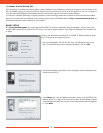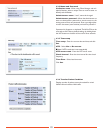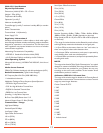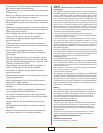
WLA-G54 Specifi cations
Physical Specifi cations
Dimensions (LxWxH) 205 x 170 x 76 mm
Weight: 1.37lbs (620 g)
Te mperature & Humidity
Operation 0¡ to 40¡ C
Maximum humidity 80%
Transit/Storage 0¡ to 40¡ C maximum humidity 80% (no conden-
sation)
Power Characteristics
Transmit Mode 1.1A (Nominal),
Power Supply 3.3 V
Regulatory Information A
Wireless communication is often subject to local radio regula-
tions. Although AirStation wireless networking products have been
designed for operation in the license-free 2.4 GHz band, local
radio regulations may impose limitations on the use of wireless
com mu ni ca tion equipment.
Networking Characteristics Compatibility
• IEEE 802.11 Standard for Wireless LANs (DSSS)
• Wi-Fi (Wireless Fidelity) certifi ed by the Wi-Fi Alliance.
Host Operating System
Microsoft Windows(r) ME/98/NT4.0/2000/XP, Unix/Linux/
MacOS
Media Access Protocol
CSMA/CA (Collision Avoidance) with Acknowledgment (ACK)
Radio Characteristics (Typical Indoor Ranges)
R-F Frequency Band 2.4 GHz (2400-2483 MHz)
11 selectable sub-channels
Modulation Technique Direct Sequence Spread Spectrum
• OFDM for High Transmit Rate
• CCK for High & Medium Transmit Rate
• DQPSK for Standard Transmit Rate
• DBPSK for Low Transmit Rate
Spreading 11-chip Barker Sequence
Bit Error Rate (BER) Better than 10 -5
Nominal Output Power 15 dBm (32mW)
Transmit Rate / Range
High Speed 54Mbps
Standard Speed 20 Mbps
Low Speed 1 Mbps
Open Offi ce Environment
160 m (525 ft.)
270 m (885 ft.)
400 m (1300 ft.)
550 m (1750 ft.)
13
Semi-Open Offi ce Environment
50 m (165 ft.)
70 m (230 ft.)
90 m (300 ft.)
115 m (375 ft.)
Closed Offi ce
25 m (80 ft.)
35 m (115 ft.)
40 m (130 ft.)
50 m (165 ft.)
Receiver Sensitivity -69dBm, -72dBm, -77dBm, -81dBm, -85dBm,
-88dBm -87dBm -90 dBm -92 dBm (depends on data rate)
Delay Spread (at FER of <1%) 65 ns 225 ns 400 ns 500 ns (depends
on data rate)
• The range of wireless devices can be affected by metal surfaces,
solid high-density materials and obstacles in the signal path.
• In Open Offi ce environments, clients can “see” each other, i.e.
there are no physical obstructions between them.
• In Semi-open Offi ce environments, work space is separated by
room dividers; client cards are at desktop level.
• In Closed Offi ce environments, workspace is separated by fl oor-
to-ceiling brick walls.
NOTE:
The range values listed in Table “Radio Characteristics” are typical
distances as measured at Buffalo Technology AirStation laborato-
ries. These values are provided for your guidance but may vary
according to the actual radio conditions at the location where
the AirStation product is installed.
AirStation IEEE 802.11 Channel Sets
The range of the wireless signal is related to the Transmit Rate of
the wireless communication. Communications at a lower Transmit
range may travel longer distances.
Center Channel ID FCC
1 2412
2 2417
3 2422
4 2427
5 2432
6 2437
7 2442
8 2447
9 2452
10 2457
11 2462 1
1 default channel


















